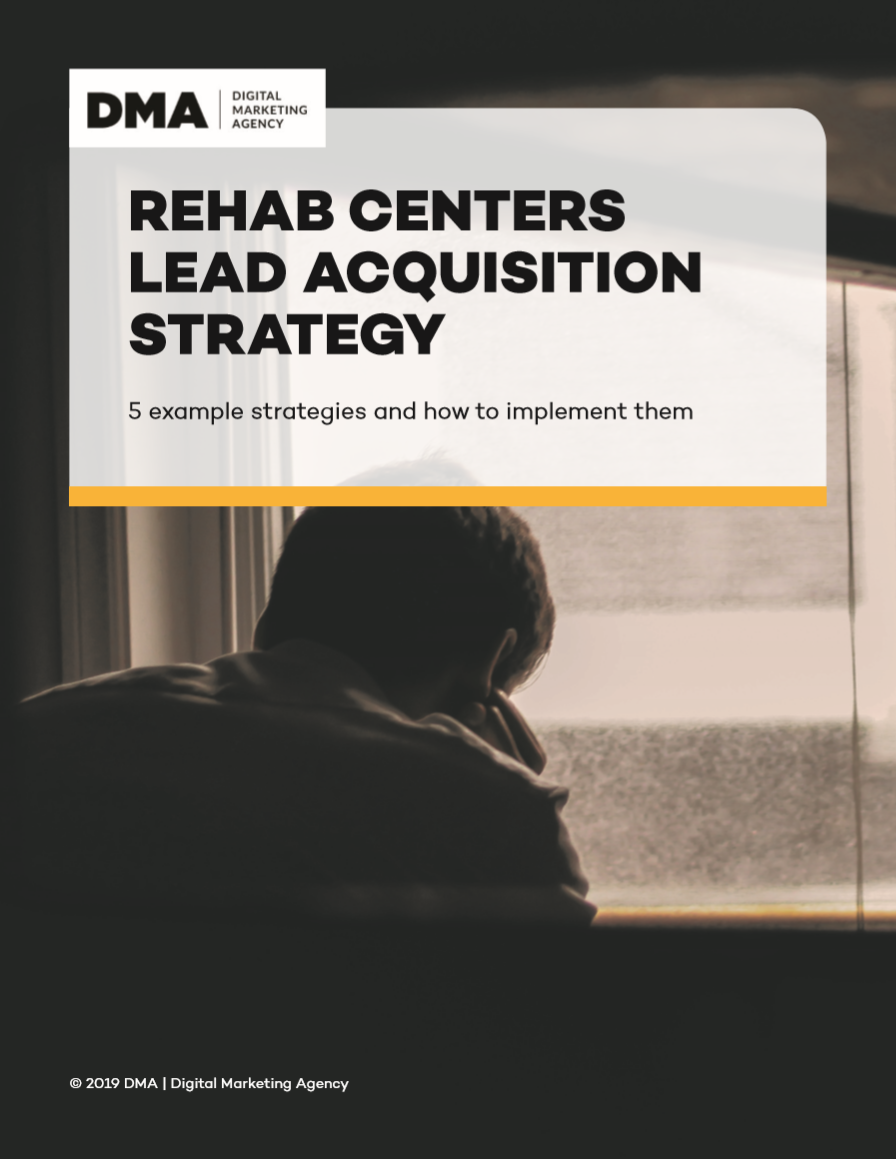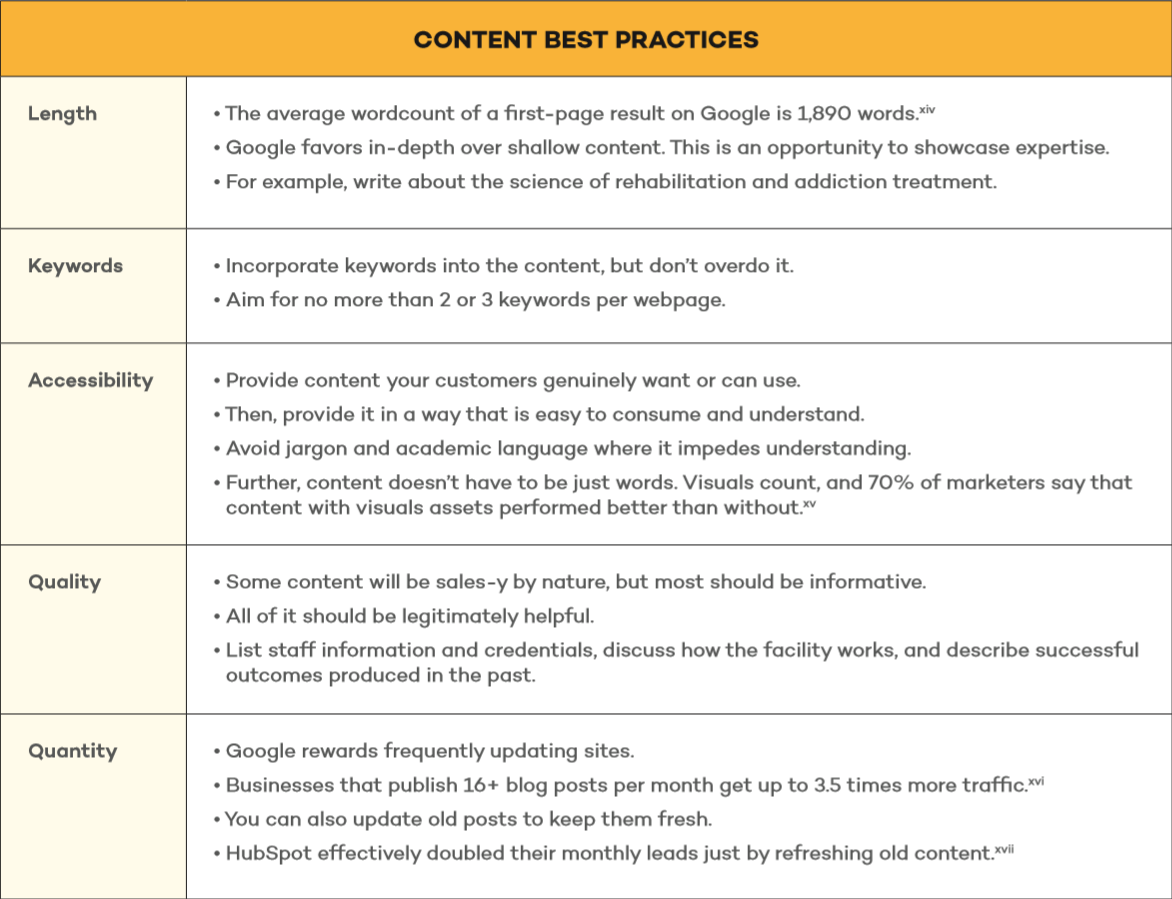SEO
Free SEO Analysis
SEO Services
Content Marketing Services
Local SEO
Link Building Services
Specialized SEO Services
PPC
REPUTATION MANAGEMENT
Free Reputation Management Analysis
Reputation Management Services
Review Management Services
Specialized Reputation Management Services
CEO Reputation Management
Brand Enhancement
Business and Directory Listings
Comprehensive Reputation Management Audit
SOCIAL MEDIA
Free Social Media Analysis
Specialized Social Services
WEB DEVELOPMENT
Free Website Analysis
Web Design Services
Mobile Development Services
Website Maintenance Services
Specialized Development Services
MARKETING AUTOMATION
Free Marketing Automation Analysis
Specialized Marketing Automation Services
Comprehensive Marketing Automation
INDUSTRIES
ABOUT DMA
WHITEPAPER
Rehab Centers Lead Acquisition Strategy
20th August 2022
Executive Summary
Google has imposed significant restrictions on rehab center practitioners, which makes it harder for all providers in this sector to advertise successfully.
A good search engine optimization (SEO) campaign should always be the starting point for acquiring new leads online.
Search advertising – also known as paid search and pay-per-click (PPC) advertising – puts you in the driver’s seat

There’s a large market of individuals who need rehabilitative addiction treatment. Can they find your facility?
McKinsey & Co. analysis found the opioid addiction problem is significantly underdiagnosed. Only about 11% of people with substance use disorders are receiving treatment; that, in turn, means that about 18 million people in need are not receiving care – a number that may be growing.[i]
Indeed, admissions to treatment facilities surged 600 percent between 1999 and 2008 alone, according to a study by the Centers for Disease Control and Prevention.[ii]
Yet, this is a notoriously difficult market in which to reach prospective patients and generate leads from the population of people who need help.
Skyrocketing growth has led to an explosion of providers, so it is an intensely competitive environment. Further, many providers have used unethical, exploitative advertising and referral practices (which means legitimate rehab centers are competing against unscrupulous ones willing to do anything to get patients).
Unfortunately, that bad behavior by those centers and brokers has led both lawmakers and search engines like Google to impose significant restrictions on industry practitioners, which makes it harder for all providers in this sector to advertise successfully.
Those changes are also leading the market into a time of upheaval.
“Those two steps will clean up the industry,” said Hunter Peterson, a partner at the Riverside Co., which operates residential treatment centers in Florida and Texas, told Modern Healthcare. “[But they] may wipe out 75% of the mom-and-pop operators in the next two years.”[iii]
Fortunately, opportunity still abounds for forward-thinking modern rehabilitative addiction treatment centers to successfully reach the people who could benefit from their services, particularly online.
How can you stand out and successfully generate leads in such a competitive and turbulent market? This paper will present five ways.
1: Implement search engine optimization
A good search engine optimization (SEO) campaign should always be the starting point for acquiring new leads online. Why? Nearly nine out of ten (86%) of individuals seeking drug or alcohol treatment use Google search before scheduling their appointment, and the best way to reach them is to have your website appear with relevant content when they search for information.[iv]
In fact, showing up in the search results offers serious value in capturing new leads, because not only do top-ranked pages get more traffic, leads generated from online search are also two times more likely to convert.[v]
But SEO is only effective if the searchers see your site show up in the listings. That means rehab and treatment centers must show up on Page One of search listings, because fewer than 2% of all Google searchers will click over to Page Two of search results.[vi] A good SEO program is the only way to show up on Page One in the organic search results (you can also pay to appear; we’ll discuss that in Section 4 below).
You can also use SEO strategically if there’s negative content about you online (e.g., bad reviews). If you can dominate the first page of search results, you can shoulder other content off the first page to the second, where the vast majority of searchers will never see it.
How do you get started with SEO? The table below highlights the hallmarks of a successful SEO campaign.

2: Use Content Marketing
Another way to generate leads: publish good content that is useful, helpful, and appealing to prospective patients.
Content marketing works on several levels simultaneously. For one, content is a critical component of SEO; an abundance of good content helps websites to rank higher in search results.
For another, content that communicates expertise and credibility can be enough to convince a reader to inquire for more information and become a lead. In fact, such content can be particularly important and impactful due to trust issues plaguing the addiction trust industry.
Indeed, trust is at a premium in this market; thanks to ethical and legal issues with patient brokers and unscrupulous treatment providers, skepticism has risen. As a result, more patients than ever do more due diligence than ever. According to Google, 76% of these patients reviewed the websites of treatment centers while researching for the best facility.[xiii]
So, your content needs to provide information that searchers can use to establish trust. In general, that means showcasing expertise and incorporating trust factors like patient success stories. Content should answer questions about your methodology and facility and give prospective patients a feeling of confidence that you can genuinely help them.

3: Manage and Leverage Reviews
Reviews alone can generate leads, but only if they’re good reviews: having five reviews results in purchase likelihood increasing by a factor of almost four times, according to the Spiegel Research Center.[xviii] In fact, over two-thirds (68%) of Americans report that positive reviews make them more likely to do business with the company being reviewed.[xix]
Bad reviews, by contrast, have the opposite power: they can kill potential leads. A single negative review can drive away approximately 22% of customers.[xx] Three negative reviews can drive away 59% of the customers.
And rehab center clients certainly read reviews. Rehabs.com, an American Addiction Centers resource, reports that 46% of people would deliberately avoid an addiction treatment provider if they were unable to find any reviews of their services.[xxi] That’s because prospective patients want to know if a given treatment center will really help them. To do that, they don’t just look up the main website; they also want to know what former patients have to say.
In other words, trust-building doesn’t end at your website, and managing reviews is critical. You can either leverage them to build your pipeline of leads, or you can let them sap your ability to get new patients in the door.
Of course, treatment centers don’t have direct control over reviews, and you will get negative reviews (it’s unavoidable); but you can also manage the process to cultivate more positive reviews and decrease the incidence of negative reviews.
4: Advertise with Google
SEO is not the only way to show up when a prospective patient searches for information about addiction treatment. Search advertising – also known as paid search and pay-per-click (PPC) advertising – puts you in the driver’s seat: you're guaranteed to show up for your chosen keywords, and your website will show up above the organic search results if you successfully bid for top placement.
But rehab centers and addiction treatment facilities face some special considerations around advertising because Google restricts the advertising that happens in this space.
To advertise with Google, rehab centers must be certified by third-party organization LegitScript, which verifies medicine-related businesses online.[xxii]
The reason is that too many bad actors were advertising for these services; consequently, people were clicking on ads for brokerage services rather than reputable addiction treatment centers, with "people looking for help [being] essentially traded like commodities and sent to incredibly expensive 'addiction centers' that often provided little recovery help at all," as reported by TechCrunch in an exposé of the practice.[xxiii]
Google subsequently turned off all addiction-related terms for AdWords until they settled on the LegitScript certification solution. LegitScript uses a 15-point checklist to verify recovery centers are the real deal. Some organizations, like sober homes and referral agencies, are simply not eligible for certification, and they “are not allowed to advertise for drug and alcohol addiction services on Google.”
5: Cultivate Legitimate Referrals
As discussed previously, the rehab center industry has a dark underbelly of unscrupulous brokers who funnel people in need to expensive centers in exchange for compensation. That has brought scrutiny on the referral process. However, serious treatment facilities cannot ignore legitimate referrals as an important source of leads. That means cultivating relationships with the people and organizations who can provide those leads.
See the sidebar for some suggestions but note that one of the most undervalued sources of referrals is program alumni. In fact, maintaining relationships with alumni does double-duty. It’s helpful in preventing relapse (between 40% and 60% of recovering addicts eventually relapse, according to Recovery.org), and alumni can also be a good source of referrals if their friends, family, or other associates may also be struggling with some form of addiction.
Conclusion
It’s a tricky time for rehabilitative addiction treatment centers. “The good news is the addiction provider side has been resource-starved for 50 years, and now the money is flowing in,” Richard Frank, a health economist at Harvard University, told Modern Healthcare. “The less good thing is that expanded supply includes both legitimate organizations and folks who seem somewhat exploitive. The challenge is going to be separating the wheat from the chaff.”[xxiv]
This presents not just a challenge for those seeking addiction treatment; it creates a problem for legitimate rehab centers to figure out how to position themselves so that they stand out from the bad actors and underperformers in the industry to successfully generate more leads from the people who genuinely need their help.
Fortunately, today’s treatment facilities have many options in this endeavor. From working to appear in the search results when a prospective patient searches for information online, to content marketing and review management, to the old standby of referrals, addiction treatment providers can grow their customer base through simple, straightforward steps.
Note, however, that many of the techniques described in this paper require their own niche expertise. While many treatment facilities are skilled in helping people dealing with addiction-related issues, their knowledge might falter when it comes to developing effective customer acquisition strategies. Absolutely, addiction treatment centers can do a lot to promote themselves online without outside help. But to really stand out in an increasingly crowded field, consider outsourcing to those who can quickly, knowledgeably, and deftly help pull in new leads.
[i] https://www.modernhealthcare.com/article/20181124/NEWS/181129978
[ii] https://www.cnbc.com/2018/06/06/opioids-hidden-epidemicfraudulent-drug-treatment-centers.html
[iii] https://www.modernhealthcare.com/article/20181124/NEWS/181129978
[iv] https://www.thinkwithgoogle.com/research-studies/the-digital-journey-to-recovery-treatment.html
[v] https://www.thinkwithgoogle.com/research-studies/the-digital-journey-to-recovery-treatment.html
[vi] https://www.smartinsights.com/search-engine-marketing/search-engine-statistics/
[vii] https://www.oracle.com/webfolder/mediaeloqua/documents/Content+Marketing+Kapost+Eloqua+ebook.pdf
[viii] https://backlinko.com/search-engine-ranking
[ix] https://backlinko.com/search-engine-ranking
[x] https://en.wikipedia.org/wiki/Mobilegeddon
[xi] https://www.doctor.com/cxtrends2018
[xii] http://www.go-globe.hk/blog/local-seo/
[xiii] https://www.thinkwithgoogle.com/research-studies/the-digital-journey-to-recovery-treatment.html
[xiv] https://backlinko.com/search-engine-ranking
[xv] https://contently.com/resource/libris-visual-content-report/
[xvi] http://blog.hubspot.com/marketing/blogging-frequency-benchmarks
[xvii] https://blog.hubspot.com/marketing/historical-blog-seo-conversion-optimization
[xviii] http://spiegel.medill.northwestern.edu/online-reviews/
[xix] https://www.brightlocal.com/learn/local-consumer-review-survey/
[xx] https://www.brightlocal.com/2017/03/15/the-impact-of-online-reviews/
[xxi] http://clientreach.rehabs.com/addiction-treatment-marketing/
[xxii] https://support.google.com/adspolicy/answer/7683376?hl=en
[xxiii] https://techcrunch.com/2018/08/02/google-slowly-lifting-ban-on-addiction-center-ads-after-adding-vetting-process/
[xxiv] https://www.modernhealthcare.com/article/20181124/NEWS/181129978
Our Sales team